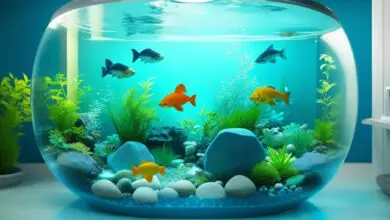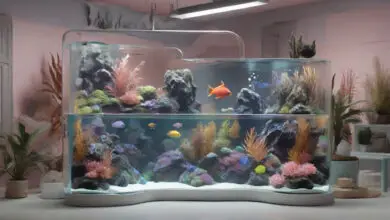Fixing Broken Down Aquarium Filters

Filtration is very important for any fish tank. Filters take harmful waste out of the water. But pumps also break from wear and tear over time. Owners must notice changes in flow or rising tank dirt. Simple testing catches problems before fish get hurt. Then cheap repairs or part swaps bring back clear water again.
Knowing how filters work inside helps troubleshoot issues faster. Fixing clogs or broken parts is much cheaper than brand new systems. Almost any common problem has an easy do-it-yourself solution once identified.
Signs of Filtration Failure
Tanks stay clean when filtration runs normally. But over months of gathering gunk, flow and mechanical filtering suffers. Water quality degrades needing more water changes. Clues of insufficient filtration building up slowly include:
- Reduced Filter Flow
- Rising Temperature
- Increased Algae Growth
- Excess Debris Accumulating
- High Nitrates
Catching problems early keeps tanks stable. Filters should run flow tests monthly. Use thermometers to check if equipment overheats from issues. And monitor if nitrates creep above 20 ppm more often suddenly.
Step-by-Step Diagnosis Process
Diagnosing filter problems takes following a logical path checking components. Start cheaply with flow checks before buying all new replacement parts immediately.
1. Confirm Low Flow Issues
Use outlet flow meters to measure gallons moved per hour. Filters should still flow around manufacturer rated levels or at least 50% after bio gunk builds up. Flow drops below 50% indicate rising restrictions inside limiting function.
2. Check Impeller and Intake Pipe Condition
Examine impeller assembly and intake tubing. Remove covers seeing if debris clogged up either side straining water entry. Use tweezers pulling out gunk carefully. Try scrubbing parts down too using old toothbrushes and filter rinse solution to clear more stubborn buildup or ooze stuck on. Clean any loose buildup present.
3. Assess Impeller Condition and Position
Check impeller spins freely once removed also. Magnets must still work properly so motors turn the unit with force. Put assembly back in correct alignment so flow pushes optimally. Position makes a big difference.
4. Address Mechanical Stage Filter Pad Condition
See how dirty original filter floss or sponges appear when running for many months on end. Toss out for fresh pads if very clumped together and falling apart. This prevents further debris passing deeper inside motor areas. Avoid complete blockages happening with beat up old media still installed.
Address these four potential issues first when tackling insufficient flow problems. Finding and fixing clogs both boosts gallons moved and also saves on electricity with regained energy efficiency.
10 Common Easy Fixes for Aquarium Filters
Once owners pinpoint likely internal clogs or breakdown causes limiting water turnover within filters, many cheap fixes exist returning units into smooth order. Avoiding brand new purchases makes the hobby much more affordable long term taking a bit of patience up front reviving dirty pumps.
1. Soak and Scrub
Simply thoroughly rising whole filters with clean water can dissolve and break up tremendous waste amounts over several hours. Scrub any surfaces with layers of brown gunk or white precipitate accumulation using old toothbrushes. Especially work cleaning impeller assembly parts and container interiors where flow immediately enters machines. Extra elbow grease brings pumps back from the dead when no clear restrictions appear right off visual inspection. Take units entirely apart if needed to reach all internal spaces equally. Hardest to reach crevices hide sneaky flow blocking buildup.
2. Decrease Media Volume
While most suggest piling biological filtration material higher for maximum benefit, overflowing containers actually reduces flow more over time. Removing half of old granular media restores original gallons per hour rates manufacturers expect filters can still output later in operational lifetimes. Only newcomer tanks truly need dense bio balls or sponges to lessen cycle chemicals early on. Long running systems hold way more good bacteria than what flows through media containers at any given moment.
3. Install Prefilter Sponges
Catching larger debris using addons like filter intake sponges further reduces particles passing interior channels down the line. This delays needing to open up whole machines cleaning out those finer locations much longer. Reducing future buildup frequency also lowers risks of outright killing built up bacteria essential to processing waste for fish health when doing deeper cleanings only every few months. Give good bacteria a clean home for peak health just like fish.
4. Lubricate Impellers and Shafts
If impellers spin fine but water flow still seems lower than expected, try adding pure mineral oil or petroleum jelly onto the central rotating shaft. Metal rods eventually wear down from friction losing smooth surfaces. Lubrication makes shafts spin faster again with reduced mechanical drag during high speed operation. Just avoid getting any oil into filter chamber areas still submerged to prevent runoff accumulating long term internally on parts not needing slippery coatings.
5. Bleach Soak Flow Reducers
Some fancy shower filters or permeable reactive barrier inserts limit water leaving media trays down to trickling levels intentionally. But over years slime residue slowly clogs up those smaller outlet holes or pathways too. Soaking horsehair overflow barriers or stainless steel reducer pieces in water mixed with bleach clears all soft blockages after a few hours. Rinse well before reinstalling clean pieces. Flow restores to expected design thresholds once more.
6. Realign Impellers
If pumps sound like they strain staying on, check magnet positioning around the impeller piece. Rotors sometimes slowly inch out of optimal rotational placement centered inside motors. Pull whole mechanisms out and correct angled magnets back around the metal central shaft using silicone or water proof glues if serious slipping occurs when running. Proper alignment prevents excess vibration and noise that slowly damages motor longevity when left askew scraping corners.
7. Replace Tubing
Inspect all plastic or PVC filter tubing for leaking cracks or permanent kinking bending flow over time. Crack leaks drip water lowering turnover rates each day while kinked areas restrict steady passage much sooner. Replace old rigid lines entirely using fresh soft silicon tubing offering equal flow diameters when possible. Restrict flow tubing only when intending slowed filtration speeds.
8. Level Containers Properly
Confirm filter containers sit fully level using bubble levels if water spills out from any bays internally when operating. Sometimes pumps move positions ever so slightly over months. Correct placements prevent sidewall gaps dumping media or backflow rather than driving water through intentionally. Lack of levelness also strains impeller alignment adding friction heat slowly as well.
9. Increase Pipe Sizes
Consider using wider diameter tubing runs when designing custom setups also aiding higher flows reaching tanks when possible. Steps down to half-inch obscure micro tubing definitely impedes gallons moved regardless filter power. Always maximize line sizes to prevent clogs down the road. Clean plumbing takes some forethought but avoids most issues keeping purifying turnover strong for tank health.
10. Add Supplementary Pumps
If filters cannot output enough flow still after deep cleaning and repairs, add supplementary reverse flow units like wavemakers across main displays. Driving contained water speeds up avoids particles settling providing extra agitation between cannister feed schedules. Mixing splash bars and an added recirculating pump doubles total turnover for crystal water lacking buildup spots in any tanks. More gallons simply give cleaner outcomes.
Filtration machine RPMs should ultimately decide gallons moved and not worn down parts leaking flow steadily over time. Sluggish mechanical stages trap debris turning beneficial bacteria anaerobic which then die off also dropping purification capacity even further. Do not ignore weakening filters until water grows cloudy and fish gasp surfacing. Early diagnosis when just flow drops prevents crashes allowing easy tubing flushes restoring previous vigor. Schedule monthly flow checks between deep seasonal scrubs lowering delay reactions keeping tanks healthy.
When To Replace Filters Entirely
While cleaning and repairs recover function for older filters most times, some issues do eventually warrant total replacement. Learning when upgrading makes most sense over continually fixing breakdowns saves money long run.
1. Motor Failing and Noise
Motors rely on tight magnetic pole alignments spinning impellers with force enough to push water. But vibrations and heat slowly throw off calibration loosening RPM strength over many years operation. Excess noise means motors now struggle outputting enough ongoing flow struggling on brink of failure. New filters often upgrade plug and play.
2. Irreparable Cracks Leaking
Plastic casing or glass aquariums meant filtering water also crack eventually either from drops or pressurization as seals shift microscopically. Once any structural cracks appear, leaks quicken fast splitting wider soon from an unfixable breaking point. Avoid damaging bandage attempts wasting more money than replacing very flawed whole units outright upfront.
3. Cost Overruns Fixing Repeatedly
Tally all costs making repairs over time like replacement tubing, media, lubricants and test kits verifying flow. If constantly maintaining an older filter now exceeds half the cost of a brand new fresh unit, consider upgrading finally for reliability peace of mind. Repairing for longevity holds merit until exceeding too much hassle and sunk money thrown at a mounting pile of problems arising with age. Each case warrants a total financial analysis when useful service life finishes.
Bonus Filter Additions Further Improving Function
Upgrading filters makes maintaining tanks effortless for years before potential issues creep back up. But pairing new systems with preventative prefilter attachments extends that long gap between necessary deep cleanings and repairs even longer for convenience. Consider adding:
1. Intake Sponge Screens
Filter shield intakes stop larger gunk passing deeper into small impellers and tubing. Sponges offer cheap insurance by trapping debris halted at first filter contact point. Hand wash outside sponges rather than constantly opening brand new systems chasing clogs building up internally over shorter intervals. Prolong seamless mechanical operation.
2. Wavemakers
Battery or electric powered recirculation pumps drive supplement water flows between main filtration feed intervals. Their added turbulence shakes free particles avoiding settlement while also well oxygenating tanks with bonus aeration too. Constant water motion eliminates local deadzones or film building areas which harm biological balance and health over time. Reduce their speeds or redirect positioning if causing too much surface rippling however for calmer species tanks.
3. Media Bag Filters
Finishing polish filters stop nearly invisible floating particles making tanks slightly hazy even with big filters running. Dense micro media bags filter down to 10 microns absolute utilizing pillows containing resin beads, activated carbon, and ion exchange mixtures. Giant marine systems position bag filters before UV clarifiers to amplify their penetration effectiveness. And planted freshwater tanks remove organics preventing future nutrient export issues keeping growth easiest for beginners. Polish filters make water sparkle after simply replacing filter inserts alone just every few months as bags load up trapping prior cloudy sources.
Adding supplemental filtration gear or preventative prefilters maximizes new system investment lifespans greatly. Deal with replaceable attachment gunk more often rather than frequently accessing directly into main filtration machines possibly losing good bacteria trying to remove all built up masses since last deep clean a year ago. Care for the small things improves longevity of the core filtration heartbeat driving every aquatic ecosystem long term.







